An armchair sailor’s dream charter comes true (published April 2014)
It all began one cold and snowy winter day in the northeast while watching an episode of “Distant Shores” that included a section on the Shard’s voyage to Norway. A few days later a reference to a new digital version of a cruising guide to Norway by Phyllis Nickel and John Harries caught my eye and magically ended up on my lap, or rather my iPad, in a matter of seconds.
My wife Gloria is not particularly keen on sailing in cold and rainy weather, but Phyllis and John’s enthusiasm, breathtaking photography, and detailed cruising and guide book style information won her over to considering such a project. The hiking opportunities right off the boat, similar to what we enjoy so much during our Maine summer cruises clinched the deal, subject to finding a well heated, raised saloon charter boat. We have learned to appreciate the convenience of a real raised saloon configuration, such as our Southerly 42RS, where one can still watch the tide come and go while at anchor, comfortably and warmly seated “down below” on a cold, foggy or rainy day.
MAKING IT HAPPEN
After many days spent on research and armchair exploration with the Norwegian Cruising Guide and other online resources, we settled on a two week charter towards the end of the sailing season, which is in mid August. Our destination would be halfway up the coast, just north of Bergen, where the fjords promised to be the most spectacular, the hiking opportunities challenging, and the sailing not as difficult or cold as it would be further north.
The next steps were to find the right boat and book the flight. Finding a charter boat in Norway is not as easy as one would expect and none of the worldwide charter companies we are familiar with operate there. Instead, there are many very small (one or two boats) outfits scattered along the coast, with some of them offering their boats through charter brokers. We chose a UK broker (yachtcharternorway.com) for their English website, and professional and prompt response to our inquiries. Louise was a pleasure to work with, she facilitated the process tremendously, and wiring payments to an established company added peace of mind.
OFF TO NORWAY
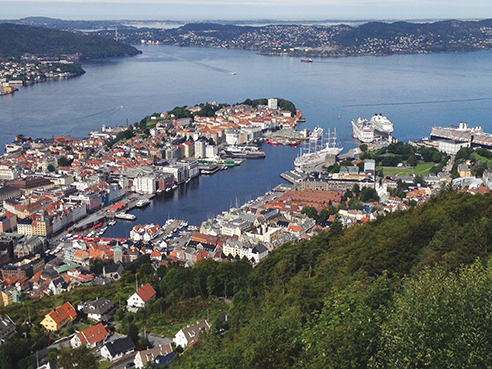
We flew into Bergen on a sunny and warm Friday afternoon where we had booked a room for the night so we could explore this beautiful town, check out the waterfront scene, and acclimatize a bit to the country before boarding our bareboat charter the next day. We generally rent a car for this kind of trip to help with provisioning and luggage, but I was glad I did not this time, because the signs and directions, most not in English, were very hard to follow. On the other hand, every person we interacted with while in Norway understood English to some degree, most of them proficiently.
Spending a day in Bergen was the right choice. Not only is the town well worth a day to explore, but the hike up the adjacent hill offers beautiful wooded trails and an amazing view of the town and the fjords beyond. It was also good to not come to Bergen by boat, as the waterfront was packed with cruisers three or four deep and the party scene looked set to go late into the night, which is not our cup of tea.
Speaking of partying, the issue of alcohol provisioning is worth a note here. Although beer is readily available in grocery stores, wine and spirits are quite expensive and only available at the airport if flying in from a non-Schengen country such as the UK (four wine bottles per person allowed), or at very few and far apart government owned liquor stores (see vinmonopolet.no). In addition to Bergen, there was only one other store in our cruising area, three days north of Bergen in Hoyanger at the end of a small fjord half way into Sognenfjord, an 80 mile fjord we were going to explore. Furthermore, the store is only open Wednesdays to Saturdays. So, serious planning is required on the provisioning side of things.
As for food provisioning, almost every small village we visited had a reasonably sized grocery or convenience store. Plan on extra time for your first visit to the grocery store, as it is not easy to figure out what you are getting, including something as simple as whether a bottle of water is flat or not.
A BOAT FOR THE ELEMENTS
The boat we chartered was a Bavaria 40 operated by West Boat Askoy, out of Florvag Marina in North Bergen, a short ferry ride across from Bergen. Tor, the boat’s owner, was there to greet us and help us with our luggage. We had a very pleasant boat brief and he even carried the provisioning we did at the grocery store two blocks away in his truck and to the boat. Although not a raised saloon, which we could not find, she was in mint condition, clean, well maintained and equipped, including chart plotter, bow thruster, and fully enclosed cockpit canvas covers. I do not particularly like fully enclosed cockpits on sailboats, but we learned to appreciate them in Norway as our carefully chosen location turned out to be the wettest part of Norway.
The Webasto heater worked well in the main saloon and heads, but was not installed in the cabins, as this is not something Norwegians think is necessary. However, the berths were made up with sheets and very warm down covers. The boat was also equipped with an oversized engine, something we learned to appreciate as most days had either little or no wind, or very strong gusts from dead ahead, sometimes both.
It rained 10 out of the 14 days of our cruise, and in several occasions we were told, “there is no such thing as bad weather, just inappropriate clothing.” Despite the rain and cold however, we had an amazing two weeks cruising Norway. Most of the time we motored but the three days we were able to sail, either downwind or tacking up a fjord, were well worth it. Just as golfers need only one good drive and/or putt to remember a good outing, so did the three sailing days work for us.
NORWEGIAN DELIGHTS
One of the advantages of chartering in Norway either side of July, the peak season, is that there are very few boats out and about, at least north of Bergen where we were. In mid-August, most village visitor pontoons or docks were empty or had one or two visiting cruising boats at most. Although we prefer anchoring out, it was easy and pleasant enough to park the boat at a quiet pontoon and go for a walk around the village or hike a nearby mountain, particularly in rainy weather. If timed right, there is generally plenty of time to be outdoors in between squalls, and the changes in weather make the surroundings even more amazing when fog creeps up or down a hillside or the moon suddenly appears cradled between mountains arising from the sea. Although we chose to rent an inflatable dinghy so as to be able to go ashore when anchoring, or take a mooring line ashore, we never used it and it only accumulated rainwater. I suppose that in July, when pontoons are more crowded, it may have been of some use.
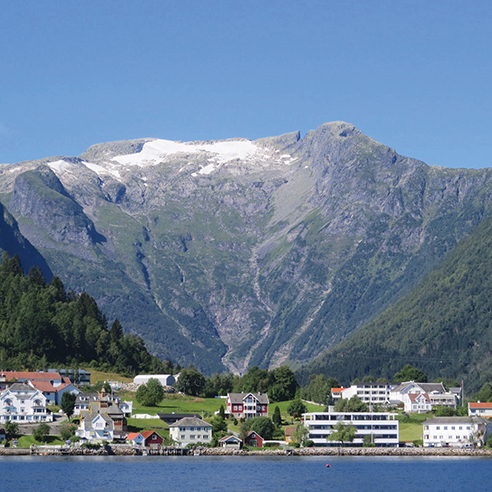
It took us five days to leisurely meander our way north and halfway into Sohnenfjorden to the town of Balestrand, an old summer resort full of history, 60 miles in from the North Atlantic due east. The hiking opportunities around town are very nice, the provisioning is great, and it is an excellent spot for crew changes. In fact, our daughter who had accompanied us for the first week of the trip was able to take a four-hour fast ferry trip back to Bergen and on to the airport for her long flight back to San Diego.
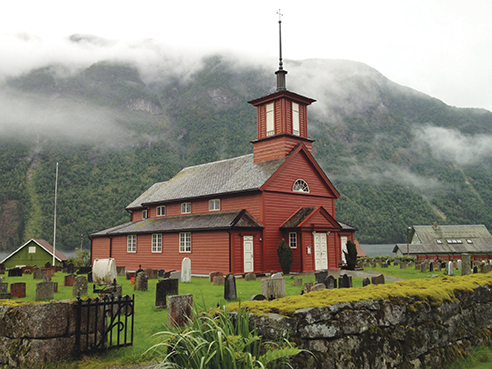
From Balestrand we motored north into a 14-mile fjord to Mundal, a sleepy town with a very interesting glacier museum just a short walk away. One of the largest glaciers in Europe sits right there on the mountains next to the museum where expeditions are organized during the short summer months. The museum includes a wide screen auditorium showing a breathtaking aerial documentary that is not to be missed. There is also a nice hike up a valley just off of the new floating pontoon behind the beautiful Victorian Inn. Mundal was the farthest point of our cruise. We had skipped several spots we still wanted to visit and felt we had done enough motoring to get there. A leisurely return through different fjords and channels might afford more sailing and hiking opportunities.
Located at the end of a little fjord off of the north side of Sohnenfjorden, the aforementioned town of Hoyander was worth a stop. In addition to a visit to the Vinmonopolet store, and the very modern and well stocked supermarket, the hiking opportunities are spectacular, particularly the 1,200 steps up a water pipe, leading to an immense plateau with trails used in winter for cross country skiing.
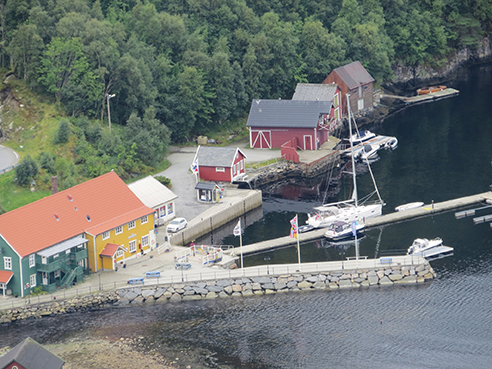
Another highlight was our stop at Dingja, a very small village with a well-stocked and friendly convenience store with free Wi-Fi and a modern well maintained pontoon. There is a hiking trail up the adjacent mountain to the east, following the road left off the pontoon for about a mile. The views from the top, looking west, show the outer islands and entrance to the Sohnenfjord.
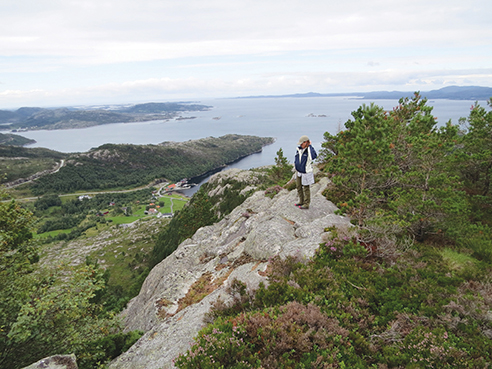
On our return trip the weather was looking good for a bit of exploration and sailing in the outer islands. Fedje proved to be a beautiful island, its barren and quite flat landscape a complete contrast to the verdant high mountains of the fjordlands to the east. This island, which according to the guidebook was settled in the 1500’s, has a year round community that mostly lives off of summer tourism. Most of the island is protected and has walking paths through marshes and rocky hills all the way to a lighthouse in the southern end. It took as about four hours to walk round the island paths, highlighted with a sail by of a traditional Viking ship that was moored at the town dock when we arrived.
All in all, the Norway cruise was a complete success. It was challenging from a navigation point of view but much facilitated by Phyllis and John’s cruising guide. Having such a guide is very important, not only for its information about the places one visits, but most importantly to choose the places to moor along the way, as the charts provided with the boat did not include a cruising guide and the charter briefing can become overwhelming if one has not carefully studied the guide beforehand. A big thank you is due to Phyllis and John for sharing their knowledge and expertise in such an accessible way.
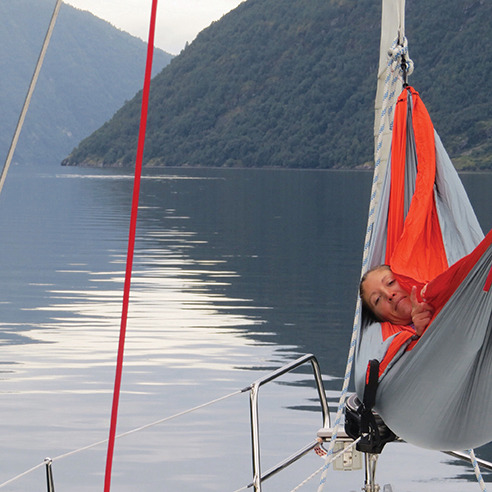 Juan Florin is a lifelong sailor originally from Argentina. He has extensively cruised the Rio de la Plata and the northeast coast of the U.S. Juan also completed a one year, 10,000 mile voyage from Portsmouth, UK to Portsmouth, NH, cruising south along the Atlantic coast of Europe to the Canaries, followed by an Atlantic crossing to Antigua, then north through the Caribbean, Bahamas and up the ICW.
Juan Florin is a lifelong sailor originally from Argentina. He has extensively cruised the Rio de la Plata and the northeast coast of the U.S. Juan also completed a one year, 10,000 mile voyage from Portsmouth, UK to Portsmouth, NH, cruising south along the Atlantic coast of Europe to the Canaries, followed by an Atlantic crossing to Antigua, then north through the Caribbean, Bahamas and up the ICW.

















